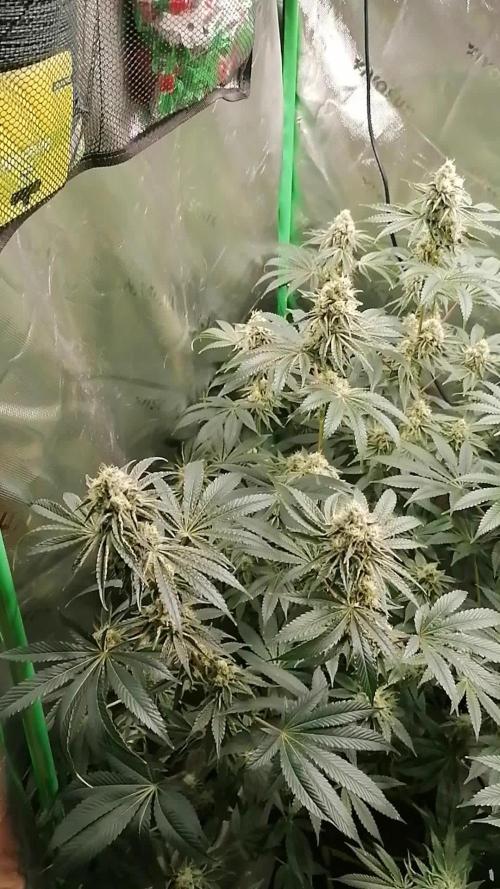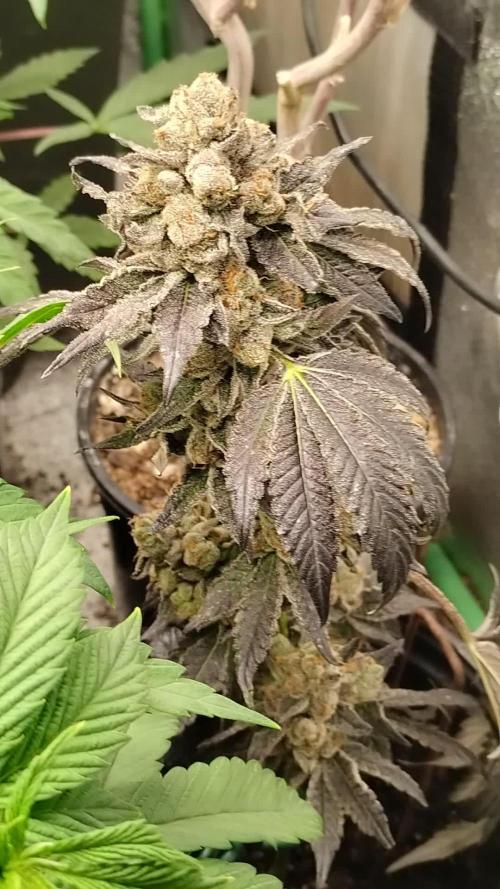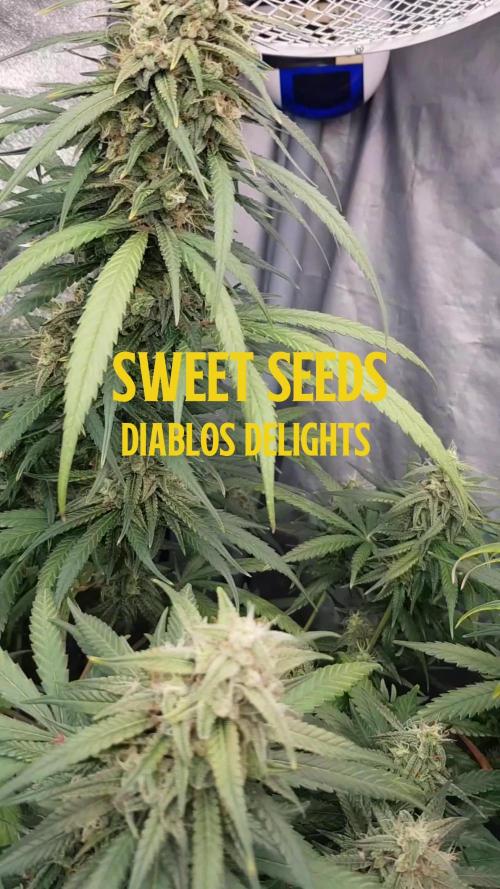The Grow Awards 2026 🏆 

































Likes
Comments
Share


@DivineBuds420
Follow
Die zweite Blütewoche startet für die Ladies mit Futter in Form von jeweils 5ml Biotabs Bio PK 5-8.
Ich starte erstmal mit der halben Dosis und beobachte wie die Pflanzen sich verhalten.
Ich habe das Bio PK in weniger Wasser (ca 300ml / 5ml / je Pflanze) als empfohlen gelöst, um die Untersetzer nicht zu fluten.
Ich nehme an bei 4 Liter Nährstofflösung pro Topf würden sonst die Wannen überlaufen.
Außerdem habe ich wieder einige Blätter entfernt.
Einige Blätter haben einen relativ speziellen Charakter.
Einige Tage nach dem letzten Blattschnitt habe ich das Netz eingehängt - besser spät als nie.
Bei der Gelegenheit habe ich auch wieder einige Blätter entfernt.
Um zu schauen was mich eventuell erwarten könnte, habe ich bei meinem Apotheker des Vertrauens ein bisschen GMO zkittlez bestellt.
Etwas speziell, gefällt mir aber sehr gut. 🙏🏻💪🏻
Die Ladies haben die zweite Hälfte Bio PK bekommen.
Die Lampe läuft auf 150W Leistung.
Likes
2
Share


@SimeonToko
Follow
Turned on the system and the airdomes. Airdomes set to 30gph. Added trellis net.
Likes
9
Share


@GardenOfHerbs
Follow
* harvest: 6 weeks veg. 60 days flowering
* pot size: 11liter rain science bag
* dry bud yield: 80gram
* Appearance: very dense buds, with a hint of purple inside
* Bud density: 9/10
* Aroma : smelling like a really sweet overripe banana
* Taste : like it smells, a really nice overripe banana taste on the inhale
* Potency : 9/10
* Kind of high: perfect if you wanna chill and have a good night sleep
* Colour of thrichs at time of harvest: 20% amber 80% milky
* Drying time: 10 days in the dry tent, curing 10 days
* Good comments: such a beautifull plant to grow with branches that are the size off your arm, the buds are all big and gorgeous, they are purple on the inside. Loving the terps on this one. This pheno was pure banana, exactly what i was looking for.
* bad comments: cant think off anything
Likes
37
Share


@Brujha77
Follow
Beginn Woche 7 Blüte
Langsam legen die Buds an Masse zu.
Außer Tank füllen ist nix zu tun als Abwarten😉
Die 50l reichen so 4-5 Tage dann muss wieder nachgefüllt werden.
Likes
37
Share


@Hawkbo
Follow
Just started them all on the Green Buzz Liquid Organics and will run it the rest of the way. I'm not going to add much to the line just some calmag, enzymes maybe terpinator I have to experiment with it a little bit. The first feed went extremely well the plants instantly reacted within an hour after the feed especially the next day. The additives in this line barely raised PPM at all which I liked. It also doesnt stink like other liquid organics I've used.
This is still one of my favorites I love the structure and seems like it should have some variation from the first pheno. It's going to get its second feed with the GBL nutes today with the rest of the crop. Day 21 of flower.
Likes
5
Share


@Brickleberry
Follow
July 5 - other crops on the lateral branches, growing strong every day 💚🔥
Likes
36
Share


@TaterheadJohnson
Follow
7/19: Started new nutrients today. Filled gallon jug with new nutes. Poured half of new nute mix in half gallon jug. Poured the entire half gallon jug into reservoir.
7/20: Bumped light intensity to 50%
7/21: Filled reservoir to the 2nd line today. Added a total of 1 gallon to res to get it to that line. Poured the rest of the mixed nutes for this week (half gallon) and then another half gallon of just plain water.
7/24: Bumped light intensity to 55%
7/25: Sadness today 😞.. While in the process of doing more LST today I accidentally snapped the main stem. I Panicked! Moved plant back in opposite direction to counteract the split. Will be monitoring very closely! 🙏🏾
***** For this Grow******
“Day Air Temperature” will be the max temp of tent for the week.
“Substrate Temperature” will be the average temp of tent for the week.
“Night Air Temperature” will be the lowest temp of the tent for the week.
Processing
Likes
38
Share


@snowybudz
Follow
There's a few plants I haven't kept a diary on in the video... they are about 1.5 weeks younger then the rest. I will be switching into flower by the end of the week unless suggested that I wait longer. What do you guys think? The area is 4 x 10 and I will be flowering with 2000 W HPS. the young plants in the left corner in 2gallon containers will not be put into flower I have a separate veg area for them. They are purple diesel.
Likes
14
Share


@Cbdjames
Follow
Well 4/5 weeks in flower and she is still going strong! She was left for 4 days and still kept stretching! She’s finally swelling and the end is coming. I used this grow to show just how much abuse these plants can take! Under the right conditions these will produce big yields of sticky flowers!
Likes
Comments
Share


@AestheticGenetix
Follow
So I went to the Oregon Growers Cup.
I was really looking for some new and special genetics.
There was this one booth with this dude that I got to talking to and they had branches of these live plants and they were absolutely stunning. I started talking and was showing him some of my best nugs and trading with him.
I made a joke even though I was dead serious, asking if I could take one of the branches and try to reveg it to be able to grow the genetic. He laughed and gave me his number to get some actually cuts from him(score!)
But anyways this is that branch, I cut the stem like you would with clones and am attempting to monster crop/ root this live Branch of award winning genetics.
I'm not positive on what the cut is. I think it might be real lemon cherry gelato, or it's gelato 41 or maybe it's a cross? They had so much freaking fire!
Likes
18
Share


@GERGrowDesigns
Follow
Dear Growers ,
Welcome to Week 8 or Flower week 5 // Day 56-63 from Sweet Seeds Diablos Delight Xl Auto.
Incase of Moving to a New Home . I Decided to skip some Weeks from every Diarie of the 12x12 Automatic Project . Everything should be Normal in the next Weeks .
Whether you're a beginner or an expert, you are warmly invited to join, ask questions, and share your own experiences along the way!
Project Setup & Conditions:
• Brand/Manufacturer: Sweet Seeds
• Tent: 222cmx150cmx150cm
• Light: 2x 720 Watt Full Spectrum
• Humidity: 50%
• Soil: Narcos Organix Mix
• Nutrients: Narcos Products
• pH Value: 6
If you want Germinitation results like mine , check out Kannabia Seeds with my link [https://www.kannabia.com/de?ref=61966] and grab the germination device or the strains I used . Trust me – it’s worth it for sure !
Get another 20% Discount at all products using the code [GGD] at the Checkout .
Stay curious and keep up Growing —we look forward to welcoming you back for the next chapter soon!
Likes
19
Share


@DevelGrow
Follow
Hallo Freunde 👋 die Mac #1 sind 14 Tage Alt und wachsen fleißig! Ohne Probleme geht es in Woche 3 und freuen uns auf das Wachstum! Growers Love keep Green and grow High ✌️🍀💚🍀
Likes
77
Share


@Ukfarmer420
Follow
Light = bloomplus bp2500 250watt actuall draw.
Exhaust is a ac infinity 6inch with digital controller
Inkbird humidity controller with a ram 5l humidifier. Veg only!
Soil= biobizz light mix
Nutes= biobizz using the 10 week schedule at half dose this run.
Heaven =2ml avti vera=2ml
fish shite= 1ml calmag=2ml
All nutes mixed to 1l of water
Ph= 6.4
Room humidity is 60%
Day Temp is 25°c
Over the last week the plants have exploded with growth, I feed them 3x last week and will do the same the week.
I will be performing lst to some of the plants later on in the week.
More pics and videos to come.
Happy growing guys 💪💚
Likes
18
Share


@NMGDOC
Follow
Don't pay attention to the small pots. I'm gonna do another diarie for them because they are in another week.
Now the regulation of humidity is great, i think that the plants do their own job regulating the humidity.
I'm in love with the @TodoGrowLed led, so easy to install. Here we are in summer and the temperatures dont exceed 27-28 C° inside. I put some ice pack inside the indoor and the temperatures were between 20-26 :)
In this week im gonna use neem oil with potassium soap, just for prevention.
Im newy, don't judge me jaja i don't know if the distance between the knots it's ok (also, i don't know if that is the right word in english jaja)
Likes
16
Share


@TAXFR33
Follow
Now that all plants are in the ground we have started to train the plants by topping and lst, nearly all my autos are transitioning into flower, the semi autos are grow massive will get some close ups on the weekend
Likes
4
Share


@Fatbudz
Follow
I said!! it's huge
ready for flowering!! one week to change the light schedule to 12/12
I've already lost count of the toppings I've made. I will always take some of the bottom leaves out. that no longer catch light and only waste energy. I water every two days. small quantities and One feeding per week. I make adjustments whenever necessary. I also don't spend a lot of nuts as long as she doesn't really need food as in flowering. you will realize soon
Likes
18
Share


@valiotoro
Follow
Hello everyone week 3 of flower has passed for this Vanilla Latte auto 🍼
Same feeding schedule
Mars hydro FC-E6500 75%
have a great day and wish you all happy growing 😎👨🌾🏻





























